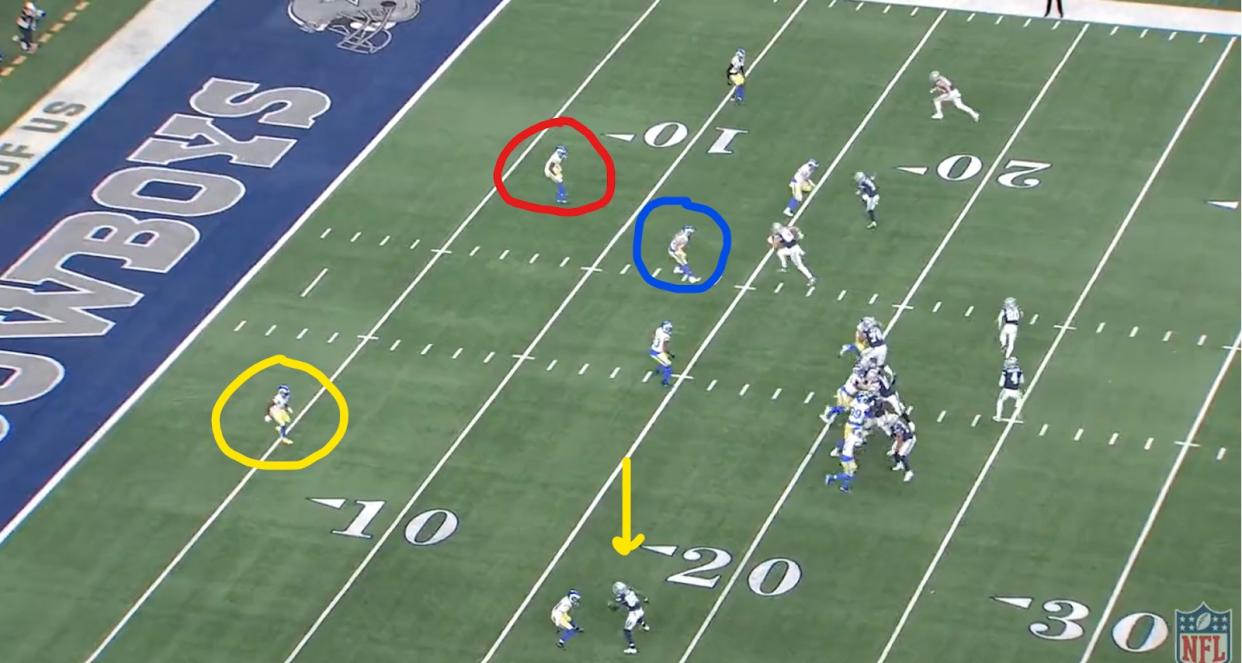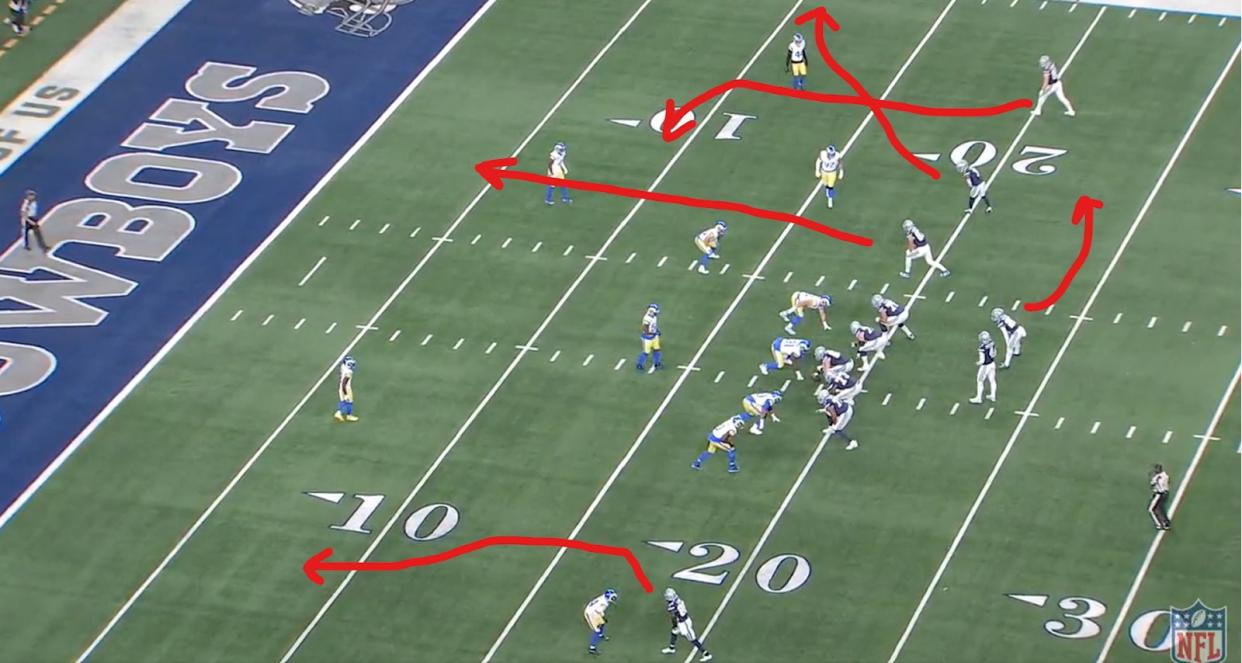The Overhang: Cowboys are finding creative ways to unleash CeeDee Lamb, and welcome to the NFL punting revolution

An awesome aspect about football is the infinite aspects that create it and ways to consume it. Whether it’s fantasy, gambling, scheme breakdowns, touchdown dances, Travis and Taylor, draft prospects, trench play, social media quarterbacks, highlights, lowlights, memes. There’s everything for everyone. With hundreds of players and coaches and personnel members and trends to monitor, it can be a fire hose of football that is overwhelming but also amazing.
This week in The Overhang, I take a look at the usage of a star wide receiver as well at a historic league-wide trend happening in the third phase of football that has affected just about every NFL game you have watched this year.
CeeDee Lamb is winning everywhere
Dallas Cowboys wide receiver CeeDee Lamb is one of my favorite examples of what I like to call the “Power Slot” archetype: a bigger body working over the middle that wins with strength and feel rather than the stereotypical undersized slot receiver — who in my head canon always wears No. 83 — that wins with quickness. And is willing to scrap as a blocker in the run game as well.
Lamb has played 62.7% of his snaps from the slot so far this season, ranking 15th among qualifying wide receivers and just ahead of route running dynamos like Keenan Allen and Braxton Berrios. Of the 33 wide receivers with 100 or more slot routes, Lamb ranks in the top five in yards per slot route run, first downs per slot route run and EPA per slot target.
Against the Philadelphia Eagles, it allowed the Cowboys to continue to pepper Lamb (and tight end Jake Ferguson) over the middle of the field. Dallas continuously got into empty formations and put Lamb against the suspect spine of the Eagles defense.
CeeDee Lamb: Power Slot pic.twitter.com/x5L1O4NIZn
— Nate Tice (@Nate_Tice) November 9, 2023
The thing about Lamb this season is not that just he’s getting targeted more in the slot, it’s that he’s getting targeted more often everywhere. That includes when he's lined up on the outside, especially as the isolated "X" wide receiver in the Cowboys' heavy personnel groupings or 3x1 formation sets.
CeeDee Lamb: X WR pic.twitter.com/aoN3yCMhb2
— Nate Tice (@Nate_Tice) November 9, 2023
Lamb has been targeted on 21.6% of his outside snaps, more than 5% more frequently than in 2022, and his receiving numbers have followed suit. Lamb is currently recording 24 more yards per game on plays from the outside compared to last season.
Lamb is not only being more effective on his non-slot snaps relative to his previous output, he’s putting up league-leading type numbers on the outside. His 4.38 yards per outside route run is first among 77 qualifying receivers. It's a preposterous average that only has Tyreek Hill — the wide receiver currently on a historic pace for overall yards per route run with 3.96 in 2023 — in the same stratosphere. Hill's 4.34 yards makes him the only player above 4 in that category, with third-place Puka Nacua sitting more than a yard behind those two.
This firepower makes Lamb the focal point of however the Cowboys want to attack an opposing defense, poking at matchup advantages and building game plans off it. Against the Eagles, it was between the numbers. Against the Rams' young cornerback group, Lamb got his usual diet of work from the slot, but doubled his pleasure and fun on the outside.
I’ve been using some advanced receiving statistics so far but it’s all to say that CeeDee Lamb has been going ballistic lately. He has 30 receptions on 37 targets for 466 yards and two touchdowns over the Cowboys' last three games.
But it’s not just Lamb that’s benefitting. The threat he presents on the outside creates opportunities for his teammates, like this Jake Ferguson touchdown against the Rams:
Linebacker attempts to wall Jake Ferguson but not enough for Dak Prescott to fire in this throw for the TD
humanahumanahumana pic.twitter.com/ShqdMJ3sXt— Nate Tice (@Nate_Tice) November 1, 2023
Dak Prescott makes a great throw, but Lamb’s alignment and the Rams' defensive structure opens up an opportunity for Ferguson. (Albeit an opportunity that is just the sliver of light. Those NFL windows, man.)
The Cowboys are aligned in a 3x1 formation, meaning three eligible receivers aligned to one side of the formation and with Lamb lined up as the isolated receiver (traditionally known as the "X" receiver). The other feature of this formation is the running back aligned strong, toward the three-receiver side, creating a 4x1 look and a true isolation for Lamb:

The Rams sit in a two-high shell. When Lamb (bottom of screen with arrow) releases inside initially on his route (known as an inside stem or "burst" release), the Rams' boundary safety (circled in yellow) will help the cornerback in coverage. This is a Cover 4 adjustment to provide a double-coverage look on a single receiver.
With no backside safety help, the Rams linebacker (circled blue) has to wall Ferguson inside, creating as small a target as possible for Prescott to attack before the other safety (circled red) can rally to help.

And because the Cowboys took advantage of the smallest of opportunities that was created by having Lamb isolated, an opportunity is presented for Lamb as well, rewarding the team play like a basketball team making the extra pass and getting a wide open layup.
Watch the next time the Cowboys get into the red zone against the Rams. Cowboys get into another 3x1 formation with Lamb isolated. But watch that boundary safety again:
this TD was a cool domino from the Ferguson TD. Will talk about in article tomorrow! https://t.co/ncQrqHqL6ipic.twitter.com/iayJSi9r3Q
— Nate Tice (@Nate_Tice) November 9, 2023
The safety pushes toward Brandin Cooks, who initially attacks vertically from that far inside spot. Attempting to learn from the previous Ferguson touchdown and take away any threat down the pipe, the safety leaves the cornerback isolated on Lamb. And Prescott promptly goes his way for the score.
Sometimes football can be that easy when you have players like CeeDee Lamb. The Cowboys' coaching staff is creating opportunities for Lamb since their bye week and he’s rewarded the focus with huge games, showing that there is even more to tap into with this talented player.
Because don’t get me started on plays with CeeDee Lamb in the backfield …
Punting has never been better in the NFL
There’s niche, and then there’s sub-niche. And then there’s “hey, let’s talk about punters!” type of niche that makes me feel like a Portlandia character writing this right now.
Because, strap in: Let’s talk about some punters.
And after that, I’ll ask: Did you read it?
Offense, defense and special teams are considered the three phases of football. Special teams to many, outside possibly the devout followers of Frank Beamer, can be seen as the throw-in phase of football. Outside of waiting to see if a field goal went in, most special team plays are the time spent transitioning between sitting and walking to the bathroom.
But, there is a golden era happening before our eyes right now. A special special teams season that, if it were to happen in another sport, would have studies happening looking into a juiced ball.
Because, quite simply: We are currently witnessing the greatest punting season ever.
NFL punters are currently averaging 47.4 yards per punt and 42 net yards per punt. Both are the highest since at least the 2000 season (and almost certainly the highest ever), according to TruMedia’s data. Continuing a recent trend of cannon-strapped punters that have been entering the league and flipping the field for their teams, the NFL’s net punting average through the first nine weeks of the season cracked 40 for the first time in 2015 and 41 in 2017, and has now risen another full yard.
And what punters are doing with the football right now sounds more like Satchel Paige describing his pitches or an onomatopoeia title card in an Adam West Batman TV show. BOOM, POW, KAPLUNK:
just 2 minutes of NFL punters booming the football pic.twitter.com/ZF06mcAnXn
— Nate Tice (@Nate_Tice) November 8, 2023
If the season were to end today, three of the top four punting seasons in terms of yards per punt would be from 2023 and seven of the top 18. Ever. Like, since Sammy Baugh was playing (his punting average in the 1940 season is fifth, by the way).
Modern punters are booming the ball, but they are also messing with things like spin and direction to create even better field position. A great example is to look at the Raiders' AJ Cole’s punt at the 35-second mark in the above tweet. It’s a 70-yard flip of field position and he aims the punt in the corner of the field, limiting the space the returner can safely return the punt.
Or the Tennessee Titans' Ryan Stonehouse, who broke the single-season average yards per punt in 2022 (this season he would be tied for the second all-time mark) on his way to being named a second-team All-Pro. All that as a rookie. But he can also put spin on the ball that would have scratch golfers asking where he got his club fitting at:
trickle trickle trickle pic.twitter.com/KvUX9MzIIu
— Nate Tice (@Nate_Tice) November 9, 2023
Why an elite punting game is so valuable
Like other positions in football and in sports, period, there is an increased specialization happening among athletes. Better training and medicine, of course. But it is easier to share information and what works as well as proliferate new ideas and tweaks.
If you are a follower of the Twitter/X account PitchingNinja, you can see in real-time how new or refurbished ideas, like the sweeper pitch, can spread throughout the highest levels of sport. What if I hold the ball like this? Or shift my weight like that? Pushing what they are capable of with not just sheer power but also creativity.
Mike Lounsberry, an analyst from NextGenStats, created a metric called Field Position Over Expected (FPOE) as a way to account for situational variables like field position, time and score for punters.
Again, it’s not just the distance that these punters are achieving. But the lack of return opportunities, or lack of quality return opportunities, they are creating. After all, punts aren’t very useful as a line drive and down the middle of the field. Punters are punting in a way to hinder returns or even the ability to catch the football:
Field Position Over Expected (FPOE) Per Punt Leaders
Weeks 1-8
1. @AJCole90#RaiderNation
2. Mitch Wishnowsky #FTTB
3. Jake Camarda #GoBucs
4. @JORDANSTOUT92#RavensFlock
5. @LoganCooke2#DUUUVALpic.twitter.com/8qxsrDmQDR— Mike Lounsberry (@Mike_Lounsberry) November 2, 2023
Those ways of changing angles and spin on the ball, along with leg accuracy, has affected teams’ ability to return the football. While yards per punt return is at its highest since 2011, this is the lowest expected points added (EPA) generated by punt returns through the first nine weeks ever per return (minus-.15) and total (minus-162.4). Weaving balls are resulting in panicked fair catches despite ample room around the returner or misplays resulting in a muffed punt and quick change of possession (ask Chiefs fans how punt returns have been going this year).
When tied in with the fact that defenses are clamping down on offenses at a rate we haven’t seen in quite some time, something I wrote about a few weeks ago, and it's the perfect storm for an offensive recession. The youngest crop of quarterbacks that we have seen in decades (that continues to get younger by the week, with players like Tommy DeVito now starting) are playing against defenses that are limiting explosive plays to the lowest rate since at least the original "Matrix" movie came out. And those defenses are being aided by the best group of boomleg punters ever. It’s like giving Goliath a slingshot.
Touchdowns, points and first downs are tough to come by right now. If a punter creates another first down for an offense to have to earn, another efficient play or two or three to try and scrap together, then it’s creating more obstacles for overmatched offenses to have to overcome. More times injured offensive lines have to be cohesive. More times the most rookie quarterbacks to play in the NFL since 1950 have to handle the ball. More plays that are more chances for the offense to make a mistake. In 2023, two of the phases are giving the other one a Dudley Death Drop. A strong and skilled punter (paired with a decent punt coverage unit) is incredibly valuable as a math changer.
Punters have distance and now also have the ability to make a football act like a knuckleball covered in spit in mid-air. To top it off, they’re also getting the ball off more effectively than ever, too. Their results reflect the more effective process of a punt operation.
All specialists in general have vastly improved over the years, including long snappers. With Bill Belichick having a fun press conference answer about the evolution of what we now call “specialists:”
This video is insane.
And a great teaching moment.
Reporter asks Bill Belichick (6x Super Bowl coach):
"Why have a long-snapper on the roster?"
Bill gives a 10-minute speech on it on the spot.
The greatest CEOs think so deeply about their craft it's almost weird. pic.twitter.com/x7ZSUKrH1c— Michael Girdley (@girdley) September 5, 2023
Why punters are getting so much better
Players are no longer playing multiple positions. Kickers, punters and long snappers are able to spend more time polishing their crafts (and practicing their golf games) throughout practice. The speed and overall improvement of the long snapper-to-punter exchange has resulted in the lowest amount of blocked punts (two league wide so far) through the first nine weeks since at least the 2000 season. It's a drastic drop from the previous 2018-2022 average of 6.8 and 2013-2022 average of 7.1.
We are reaching an age where athletes are attending camps and working with private coaches, focusing on their position and honing their craft, including players at the specialist positions. That bolsters the talent pool over time.
While most of the top punters are Americans — the top six players in punting average this year went to high school in either California or Georgia — there has been an influx of punters from Australia with a background playing Australian Rules Football. It's a trend that has greatly impacted college football in recent years, which also changes the quality of talent pool that NFL teams are drawing from.
It’s more common that an FBS college team features an Australian or another international player at their punter position. The better players are naturally reaching the NFL, and their ideas come with them. The trend was started when Australian Darren Bennett joined the then-San Diego Chargers and was immediately named first-team All-Pro during his rookie season in 1995 at the ripe age of 30. (The age discrepancy between college punters and the rest of their teammates these days is also a humorous “how do you do, fellow kids?” side effect of the trend of Australians.)
Bennett, and other Aussie Rules vets that started making their way stateside, helped popularize different ways to handle the task of the position. A cross-pollination of ideas resulted in even further specialization to the specialist position that started simply as “kick this ball high and far."
So, while punters might not be on your fantasy team (except for a few of you sickos) and good ones are generally a hindrance to points being scored — they are generally grouped with the defense, after all — just know that at least that’s quality point hindering going on.
